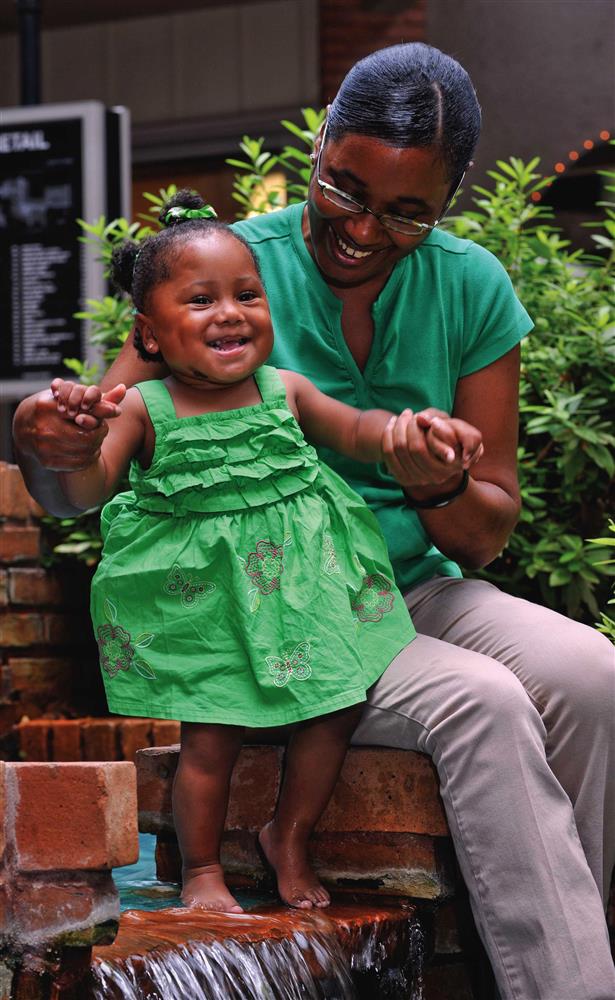Jaw-extension procedure resolves toddler's obstructed breathing

A 2-year-old Brandon girl can breathe easier now after craniofacial experts at the University of Mississippi Medical Center extended her lower jaw in a unique procedure that promotes bone growth in order to open up her obstructed airway.
Earlier this year, Taylor Brown's retruded lower jaw, the result of a rare neonatal infection, was causing sleep apnea so severe her airway would constantly become obstructed. Shortly after a normal, healthy birth in August 2009 in a metro-area hospital, Taylor suffered a severe infection of staphylococcus aureus, which wreaked havoc on her tiny body.
"Her doctors knew that she was kind of sick, but they didn't realize that it was an infection until later," said her mother Tomika Winters. After a week without success, Taylor was transferred to UMMC, where two and a half months of aggressive treatment eventually cleared up the infection. As she recovered, experts discovered that the infection had eroded bone in her hip and pelvis.
"But we didn't know that the infection had eaten her jaw," Winters said.
As Taylor grew, her breathing became more labored. In January, she had her adenoids removed, but that failed to solve the problem. That's when she was referred to Dr. Ronald Caloss, School of Dentistry faculty member and associate professor of oral and maxillofacial surgery, and plastic surgeon Dr. Michael Angel, professor of surgery.
They ordered a CT scan and discovered her retruded lower jaw was seriously obstructing her airway.
"The bone was eroded in the condyle," said Caloss, referring to the part on each side of the mandible that hinges into the temporomandibular joint (TMJ). "The resulted in her jaw and base of tongue shifting backward into her airway. The condyle is a growth site for the lower jaw. So with this being affected from her infection, her jaw has not grown forward as it normally would in childhood development."
The tongue attaches to the underside of the mandible, and as the jaw grows forward it moves the tongue forward out of the airway, he said. In order to fix her breathing, Taylor needed a bigger jaw. A jaw distraction osteogenesis extends the lower jaw using implants, allowing new bone to grow.
Jaw distraction has become an effective treatment for craniofacial abnormalities, most commonly the congenital disorder Pierre Robin syndrome. But Caloss had never heard of it being used to treat a TMJ disorder.
"I did a literature search and only found one other instance where a child had a septic joint osteoarthritis and similar treatment was performed to correct the sleep disorder," he said. The mouth has a variety of defense mechanisms and good blood flow, he explained, so it's unusual for the TMJ to get infected.
After planning the procedure on virtual surgery software and with models, Caloss and Angel cut through the bone on each side of Taylor's jaw behind the spot where her molar teeth are developing. Then, by attaching titanium distraction devices to the bone, they pushed the lower jaw forward gradually over the course of ten days. In the months that follow the procedure, new bone grows in the gaps. Caloss said they usually remove the implants four to six months after surgery.
The distraction is not as painful as it sounds, Angel assured.
"A good analogy is when you get your braces tightened and your teeth are sore. There should be some soreness but no real pain. Right now she's in no pain at all," he said.
After recovering from the surgery and the tracheostomy, performed for the procedure by Dr. Jeff Carron, associate professor of otolaryngology, Taylor immediately began sleeping better and gaining weight, her mother said.
"Before the surgery she was so severely underweight; it was hard for her to even eat. She had to drink a lot of PediaSure. But ever since the surgery, she's been going to town," Winters said.
Small scars underneath Taylor's chin are the only evidence of the surgery, and even those are hidden when she smiles, which is most of the time. Taylor sees a physical therapist once a week to improve her walking, but Winters said the damage that the infection caused to her hip means she will need a hip replacement when she gets older.
Only a handful of centers across the nation perform distractions on babies with compromised airways, Caloss said. He and Angel both are members of the craniofacial team, a multidisciplinary team of UMMC experts.
"It's very much a team approach," Angel said. "Within this area, you have multiple specialists. We have different perspectives, and when we're in the operating room it works very smoothly. Our patients benefit from this collaborative approach."


